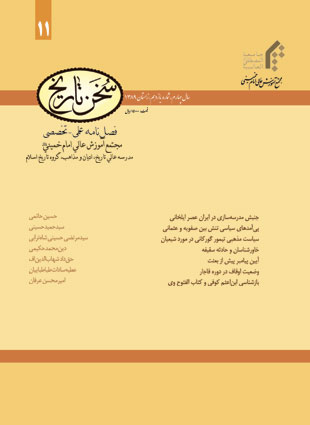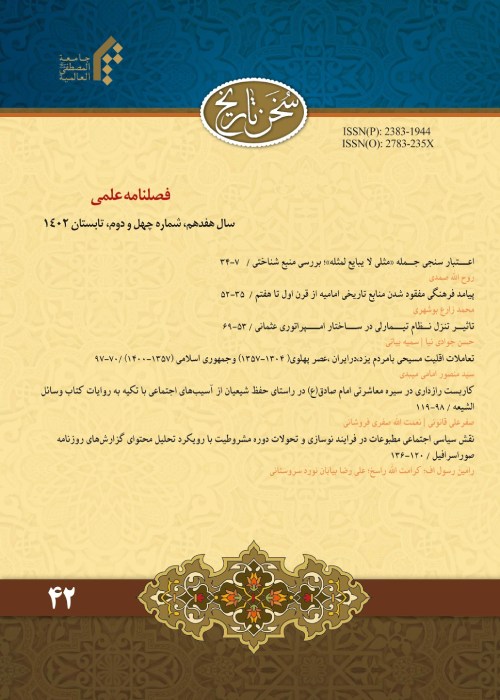فهرست مطالب

نشریه سخن تاریخ
پیاپی 11 (زمستان 1389)
- تاریخ انتشار: 1389/10/11
- تعداد عناوین: 7
-
صفحه 73
-
صفحه 113
-
Page 3Conductinga research about the history of schools as scientific and learning centers can be deemedas part of the history of any country's science and culture.Undoubtedly, the multiplicity and variety of such centers in a time and in a specific place is the sign of growth and advancement of science in that period.The second half of Elkhanian period can be counted as a turning point in the historical moments of Iran for in this period we witness the largest amount of schools and most thriving scientific centersgotestablished. Prior this time e. g. on the first decades of Mongolian dominance over Iran nothing existed in the country except complete destruction and merciless bloodshed. But simultaneously the Mongolianspolicy while endorsing and stabilizing their sovereignty inclined towardconstruction, persuasion andspreading of education and employing the learnt, competent andscholarly ministerssuch as Ata Malik Jaweni, KhojahRashed Al-DeenFazlullah, his son Ghiyath Al-Deen. Following the given policy in this epochit has eventually concluded to a remarkable increase of establishment of great scientific complexesin general and the expansion and development of sciences in particular.In this article it will be tried to introduce the most important and wellknown scientific schools of this period with geographical categorization and would re-explore their impact on Islamic-Iranian culture and civilization.
-
Page 32When the Safavid dynasty got established on 907 A.H., the people related to Ottoman held them as a rival threatening their existence. Such an assumption in more than two decades of Safavid reign caused a long lasting conflict between them resultingmiserable consequences for the world of Islam.The Ottoman Empire was counted to be the common and dangerous enemy of Iran and Europe.Their mutual sympathy prompted creation of such an idea that the convergence between Iran and Europe would lead up to Ottoman defeat for they had severe,common and subsequent war of attrition with the given empire.From other side, the Uzbeks of northeast of Iran were always in vigilant and awaiting condition to exploit any possible opportunity. When they found the Safavid people fighting a war or in a stateof weakness, they have attacked them. Moreover, Baburyan were also expecting an opportunity to make use of. In this article, the interference made by foreign states and the upheavals that played the role of backgrounds of tension between Safavid and Ottoman will be briefly touched. The conclusion this article draws is the disclosure ofthe stranger's purposes and a demand that various Islamic sects and states should take steps forward for Islamic unity and solidarity and take notice of the tactful proceedings and plans.
-
Page 57Amir Timor Gorkani (736-807 A.H) has revered the Shiite Imams and has dedicated land, agricultural field, carpet and lamps for their tombs and shrines. He loved Imam Ali (a.s) as he respected Omar and Abu-Bakr, but used to speak ill of Yazid and his father Moawyah.He was not a Shia but was a prudent man of policyexploiting the Shiite religious beliefs in favor of his own political purposes. In addition, accompanying the Sufis has softened his vision toward Islamic sects and their followers. It was the very reason ofhis tolerance and lenience toward the Shiitesas well. His conversion to Shiism (Shiite beliefs) is notconfirmed by sources and reports. The present writing having a historical approach and analytic-descriptive method deals with Emir Timor's political life and his tendency or noninclination toward Shiite school of thought. It will not leave his reverence of the Hashemite and Alavid and his affection toImam Ali (a.s) unstated. Then it will criticize his Shiite beliefs and in concluding part would study his behavior with the Shiites.
-
Page 73After the demise of the Prophet Muhammad (PBUH) the Muslim community hasdisagreedwith one another andbroke up into two splits on his vicegerency,each of them seeking his caliphateand presidency. By the way, one of the collections who were to succeed Him was the members of Saqifah council that has just been formed after the demise of the Prophet. In this council a few so-called companions of the holy Prophet were present who set aside and forgot the whole recommendations and sayings of the holy Prophet (PBUH) about Ali (a.s) and even they never informed him of theirgathering. The members of this council have made this ominous decision on the day of GhadirKhum (a day when the prophet announced Ali as his successor).For caliphate of Abu-Bakr they resorted to the following reasons such as: he has onceled the congregational prayer instead of the prophet, he is the oldest of the companions, and he has a genealogical relationship with the prophet (PBUH) (being the father in law of the prophet (PBUH)) and so on. The orientalists due to using the Sunnite sources and analyses have also put forward these approaches in their researches and books.In this article it is being tried to analyze the Orientalist's accounts on political approach and leading position of Muslim community after the demise of the prophet Muhammad (PBUH). Moreover, it would alsohandle this issue that how caliphate followed this process and what negative approaches have this style begotten after the demise of the last messenger (PBUH).
-
Page 113One of the issues that the Muslim and non-Muslim scholars have dealt with is the doctrine of the prophet Muhammad (PBUH) prior his phrophethood. Plenty ofaccounts and theories are available in this regard; some of which have gone astray to the extent that labeled the prophet Muhammad (PBUH) as idolater.In this article, only the Muslim scholar's standpoints are going to be studied. Initially, the theories will be propounded and then would be assessed and criticized. The method this research has followed is analytic and relies heavily on the writer's opinions and reports of the sources; though it has made use of the verses and traditions as well.The key and focal point that has been studied in this article with profundity and depth is the ascription of idolism to the Prophet Muhammad (PBUH) and his obedience of the predecessor Prophets. These two point of views are studied and criticized via various reasons and has ultimately reached the conclusion that the Prophet Muhammad (PBUH) has had his own particular and independent doctrine and religion.
-
Page 154The history of endowments in Iran is full of events and episodes showing the tradition of endowmentthat how it has lasted and expanded in the form of a social and organizational system. This system has played the social, economic, cultural and civil roles and responsibilities being counted as manifestations of community's public welfare and progression. Thus, in relation to this topic we can discuss the different historicalcharacteristics of endowment system from different angel and a variety of analyses in respect to the dimensions of each in the process of evolution and transformation can be afforded. The structure of organizational system of endowments in the period ofQajaris to be divided into two parts: the first period that was under the administration of clergies. This period is the continuation of the previous organizational customs. However, some sorts of proceedings have taken place for further control of endowments when the commander in chief dominated theministry of endowment. The second round is related to the years after1328 A. H. when the country's endowments laws and instructionshave passed. At this timesome efforts have been launched so thatthis institution should get further regulated and make use of the endowment's income for expansion of instructions in the country.In fact, the pillars of institutionalization of the endowment system werefounded in the second round of assembly.
-
Page 229Recognition of the historians and revival of their historical texts are of those significant necessities of the research field that the later we deal with the more harms and damageswill be brought about. The ancient historical texts holdparticular value but yet none has paid due attention to. In addition to the above-mentioned importance, introduction of IbnAtham Kofi seems necessary from two perspectives. From one hand the precedence and antiquity of his book Al-Fotoohis concerned and from other handthe irony remarks which flow over his personage raise concerns. Such disharmony andups and downs make it difficult to take the line of studying his personality into analysis. In this article along with shedding light on his biography and observing the religious, political and cultural conditions of his era we would also havea historiographical look at his method, school of thought and his work Al-Fotooh. Some writers based on existent deficiencies of his book Al- Fotooh have raised doubts about the historical reports of this book. Thoughthis book in ascription of many historical reports encounters problems but still enjoys some exceptional distinctions as well. Anyway, to review the ancient texts ofhistory of Islamis an initiativeor beginning for presenting the accurate image of what has happened during the first century of Islamic history.


